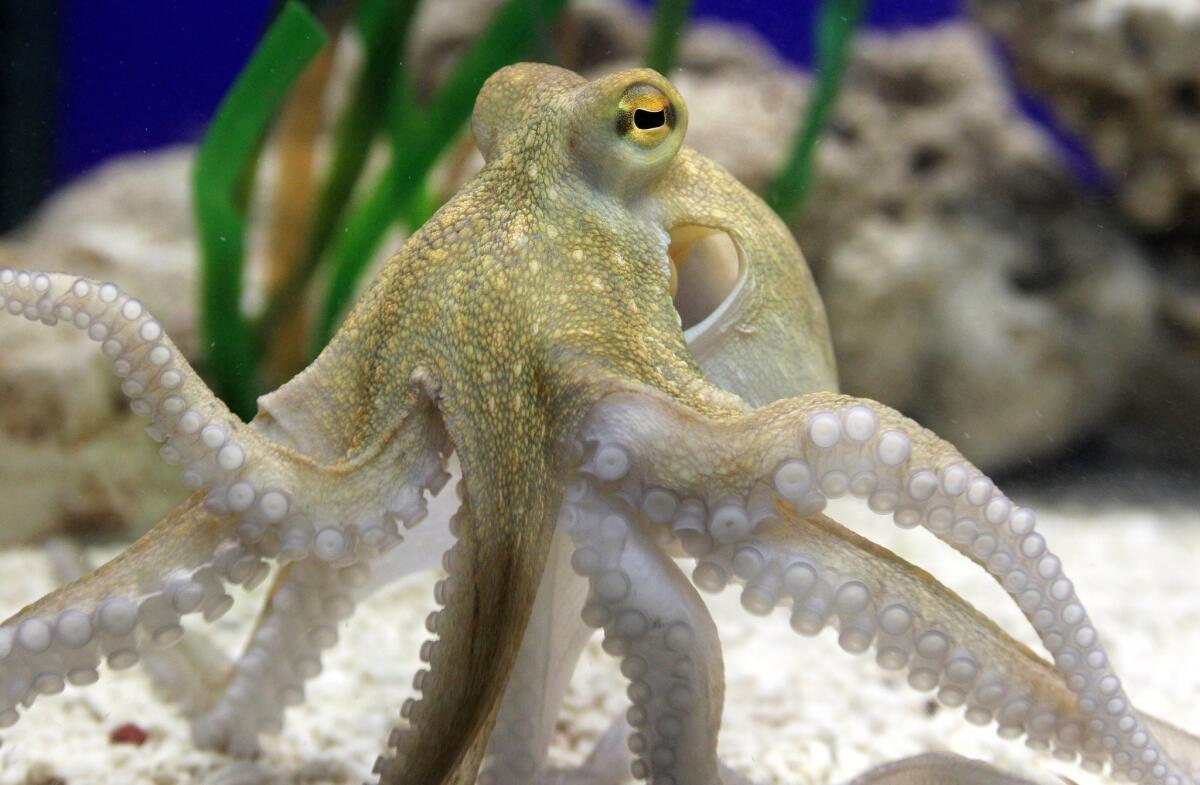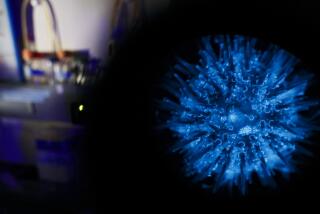Op-Ed: What the octopus can teach us

An octopus named Paul II swims in his tank at Sea Life aquarium in Oberhausen, Germany, in 2010.
- Share via
It can change color and shape. It can taste with its skin. It has a beak like a parrot, venom like a snake and ink like an old-fashioned pen, and it can pour a 100-pound body through an opening smaller than an orange. You’d have to turn to science fiction or go to outer space to find an animal more alien than an octopus.
Perhaps it’s no wonder that, from 13th century Icelandic legends of the tentacled Kraken to Jules Verne’s “Twenty Thousand Leagues Under the Sea,” octopuses (not octopi) have given people the willies. “The tiger can only devour you,” wrote Victor Hugo in “Toilers of the Sea,” but the octopus, with its “innumerable hideous mouths ... sucks your life-blood away.”
The horror of octopuses (the largest on record: a giant Pacific 300-pounder, with an arm span of 32 feet) has plagued the Western imagination for centuries. But the real creature is radically different from that, possessed with uncanny intelligence, distinct personality and superpowers humans can barely dream of.
Extraordinary new discoveries have been reported about octopuses in recent months that give the lie to the monster myth. A new species was added to the 250-plus kinds of octopuses so far described, and this one — pink and with appealing, large eyes — is so cute that the second part of its proposed scientific name is Latin for “adorable”: Opisthoteuthis adorabilis.
A team of researchers from Berkeley, Chicago and overseas sequenced the first octopus genome, revealing hundreds of genes found in no other animal — many of them active in the octopus’ unusual brain, color-changing skin and elastic, tasting suckers. The researchers found a “dramatic expansion” of some nervous system genes once thought the exclusive providence of backboned animals such as humans.
Marine biologists reported on two octopus species that appear to be surprisingly social — one of them in a large community of so-called gloomy octopuses (though the animals appeared perfectly happy) off Australia’s coast, a place christened Octopolis. Another species — the larger Pacific striped octopus, cataloged by California researchers — shares dens with mates and makes love in the position favored by missionaries.
Octopuses are remarkably intelligent, even though they are in the family of invertebrates known as mollusks, which includes the brainless clams. They learn to recognize individual humans quickly, even when they are looking up through the water at volunteers who are identically dressed, as has been demonstrated in experiments at the Seattle Aquarium.
They also can solve puzzles. One devised at New England Aquarium demanded the octopus open three plexiglass boxes, each nested inside the other, and each with a different lock, in order to retrieve a crab from the innermost cube. Every single octopus presented with the cubes figured them out. They can also open jars — and sometimes screw the lids back on — and they enjoy assembling and disassembling Mr. Potato Head and Legos.
They excel at escaping their tanks. They can lift heavy lids (a single sucker can lift up to 30 pounds) and ooze through tiny cracks. At a number of aquariums, octopuses have been known to sneak out of one tank in order to sneak into another and eat its rightful occupants. Sometimes they seem to escape simply because they are curious.
I’ve learned the truth of octopuses’ intelligence firsthand. I first met Athena, a giant Pacific octopus with an arm span of about 10 feet, behind the scenes at New England Aquarium. When the keeper lifted the lid to her tank, she turned red with excitement and slid from her lair to greet me. She looked me directly in the eye. As I plunged my hands and arms into the 47-degree saltwater to stroke her, her arms — and their strong white, powerful suckers — boiled up to meet mine. She was clearly as curious about me as I was about her.
Kali was another octopus who loved to play. Every Wednesday when I visited the aquarium, she’d rise to the top of her tank to greet me. She managed to train me and octopus enrichment expert Wilson Menashi. Unlike other octopuses — which seemed to enjoy a little play, then some fish, then more play and more fish — Kali wanted to eat everything first, which she taught us by blasting us in the face with freezing cold saltwater if we didn’t hand over all the fish immediately.
I considered every octopus I got to know a friend. That may sound odd considering octopuses and humans last shared a common ancestor half a billion years ago, back before our hearts, eyes or brains had evolved. The human brain sits like a walnut in a shell; the skull-free octopus brain wraps around its throat. And most of its neurons are in its arms, which raises the possibility of diffuse consciousness or even multiple selves.
Humans learned to make fire; octopuses learned to taste with their skin. Humans learned to paint and sculpt. Octopuses learned to create moving color patterns on their own bodies. We use ink for writing. They use it to fool predators.
Octopuses show us alternate paths of thinking and wildly different ways of being. They stretch our minds in directions far more productive than fear. We have much to learn from them. (For instance, they offer models for developing “soft robots” unconstrained by joints.) But perhaps even more valuable, by demonstrating that intelligence is more varied and emotions more universal than we imagined, the octopus stretches our moral universe.
Sy Montgomery is the author of “The Soul of an Octopus: A Surprising Exploration into the Wonder of Consciousness,” one of 10 books long-listed for the 2015 National Book Award for nonfiction.
Follow the Opinion section on Twitter @latimesopinion and Facebook
More to Read
A cure for the common opinion
Get thought-provoking perspectives with our weekly newsletter.
You may occasionally receive promotional content from the Los Angeles Times.










